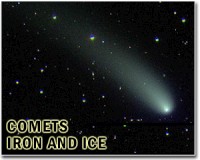 |
Washington (AFP) Feb 15, 2011 A NASA spacecraft on Tuesday began sending back the first of 72 anticipated pictures of its flyby with a comet aiming to reveal how the comet's surface has changed since it skimmed by the Sun in 2005. The initial pictures from US space agency's Stardust-NExT mission spacecraft were posted on NASA's website, and more were expected throughout the day. NASA also planned to hold a press conference later Tuesday to discuss the findings. The closest moment of the Valentine's night encounter came at 11:39 pm Estern time in the United States, or 0439 GMT, at a distance of 181 kilometers (112 miles) from Tempel 1, NASA said. The Stardust-NExT spacecraft was rapidly snapping pictures of the Tempel 1 comet as they passed. Space experts are curious to see how a trip around the Sun has affected the surface of the Tempel 1, which is about six kilometers (3.7 miles) wide and travels on an orbit that brings it as close to the Sun as Mars and as far away as Jupiter. Tempel 1 was last glimpsed in 2005 by NASA's Deep Impact mission as the comet was shooting toward the Sun on its five-year orbit between Mars and Jupiter. Deep Impact pummeled the comet with a special impactor spacecraft and the material that came out was a surprise to scientists: a cloud of fine powdery material emerged, not the water, ice and dirt that was expected. Deep Impact also found evidence of ice on the surface of the comet, not just inside it.
Share This Article With Planet Earth
Related Links Asteroid and Comet Mission News, Science and Technology
 NASA spacecraft speeds toward comet encounter
NASA spacecraft speeds toward comet encounterWashington (AFP) Feb 14, 2011 A NASA spacecraft is just hours from its long-anticipated encounter with a comet, and skywatchers hope the flyby will shed light on how the comet's surface has changed since it skimmed by the Sun in 2005. The US space agency's Stardust-NExT mission spacecraft "is within a quarter-million miles (402,336 kilometers) of its quarry, comet Tempel 1, which it will fly by tonight," NASA said in a s ... read more |
|
| The content herein, unless otherwise known to be public domain, are Copyright 1995-2010 - SpaceDaily. AFP and UPI Wire Stories are copyright Agence France-Presse and United Press International. ESA Portal Reports are copyright European Space Agency. All NASA sourced material is public domain. Additional copyrights may apply in whole or part to other bona fide parties. Advertising does not imply endorsement,agreement or approval of any opinions, statements or information provided by SpaceDaily on any Web page published or hosted by SpaceDaily. Privacy Statement |